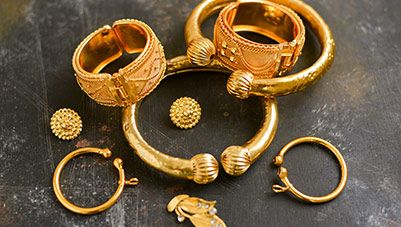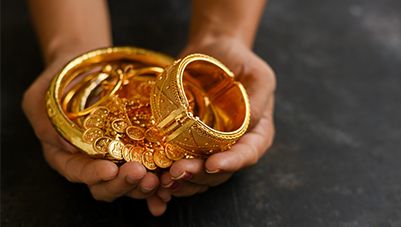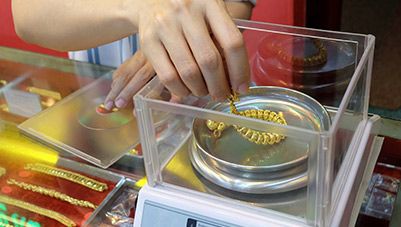भारत में आज सोने की कीमत
भारत में गोल्ड दर को समझें
भारत में सोने का भाव बहुत महत्वपूर्ण है, विशेष रूप से अगर कोई गोल्ड लोन लेना चाहता है या गोल्ड में निवेश करना चाहता है. आज सोने का भाव हमें बताता है कि अभी सोने की कीमत कितनी है. यह उन लोगों के लिए उपयोगी है जो अपने गोल्ड का उपयोग करके पैसे उधार लेना चाहते हैं या बस अपने गोल्ड की वैल्यू को ट्रैक करना चाहते हैं.
भारत में आज सोने का भाव हर दिन बदलता रहता है. ये बदलाव डिमांड, ग्लोबल प्राइस और करेंसी वैल्यू जैसी चीजों के कारण होते हैं. जब आप सोने की वर्तमान कीमत जानते हैं, तो आप लोन लेने या अपना सोना बेचने का सबसे अच्छा समय तय कर सकते हैं.
अगर आप तुरंत पैसे प्राप्त करने के लिए अपने सोने का उपयोग करने की योजना बना रहे हैं, तो भारत में सोने का भाव चेक करने से आपको यह जानने में मदद मिलेगी कि आपको कितना पैसा मिल सकता है. और अगर आप भविष्य के लिए सोने की बचत कर रहे हैं, तो आज सोने की कीमत जानने से आपको अच्छा निर्णय लेने में मदद मिलती है.
इसलिए, चाहे आप गोल्ड लोन ले रहे हों या बस यह चेक कर रहे हों कि आपका सोना कितना मूल्यवान है, आज भारत में सोने के भाव के बारे में अपडेट रहना एक स्मार्ट विचार है.
भारत में आज 24 कैरेट की गोल्ड दर प्रति ग्राम
भारत में, 24K गोल्ड की कीमत 99.9% शुद्धता के लेवल के साथ गोल्ड के सबसे शुद्ध रूप को दर्शाती है, जिससे यह निवेश के लिए आदर्श बन जाता है. 24-कैरेट सोने की मांग लगातार अधिक रहती है, जो वैश्विक मार्केट की स्थितियों, अंतर्राष्ट्रीय दरों और स्थानीय घटनाओं से प्रभावित होती है. अगर आप भारत में आज के सोने की कीमत या भारत में सोने की वर्तमान कीमत की तलाश कर रहे हैं, तो कोई भी निवेश करने से पहले लाइव अपडेट चेक करना सबसे अच्छा है. आज भारत में 24k गोल्ड की कीमत चेक करने से निवेशक और खरीदारों को अपनी खरीदारी को प्रभावी रूप से समय देने के लिए जानकारी मिल सकती है. कई लोग गोल्ड मार्केट में उतार-चढ़ाव पर नज़र रखने के लिए आज गोल्ड की दर भी ढूंढते हैं.
भारत में आज की गोल्ड दर चेक करना उपयोगी है, चाहे आप निवेश या समारोह के लिए खरीद रहे हों. भारत में सोने की कीमत को ट्रैक करने से आपकी खरीदारी के समय की महत्वपूर्ण जानकारी मिल सकती है. अपडेट रहने से आप सबसे अच्छी दर लॉक कर सकते हैं, विशेष रूप से तब जब कीमतें अनुकूल होती हैं. यह विशेष रूप से उन लोगों के लिए उपयोगी है जो मेरे आस-पास सोने की कीमतों पर नज़र रखना चाहते हैं या स्थानीय ज्वेलर के पास जाने से पहले आज ही मेरे आस-पास सोने की कीमत ढूंढना चाहते हैं.
भारत में आज 22 कैरेट की गोल्ड दर प्रति ग्राम
आज भारत में 22K गोल्ड की कीमत खरीदारों और निवेशकों के लिए एक महत्वपूर्ण भूमिका निभाती है. 91.6% की शुद्धता वाला 22-कैरेट सोना ज्वेलरी के लिए इसकी टिकाऊपन और सुंदरता के कारण पसंदीदा विकल्प है. भारत में सोने की कीमत नियमित रूप से अपडेट की जाती है और यह करेंसी एक्सचेंज, आयात शुल्क और त्योहारों और शादियों जैसे मौसमी ट्रेंड से प्रभावित होती है.
अगर आप सोने के आभूषण खरीदने की योजना बना रहे हैं, तो भारत में आज के सोने के भाव के बारे में जानकारी रखने से आपको सूचित निर्णय लेने में मदद मिलती है. स्मार्ट खरीदार भारत में सोने की वर्तमान कीमत पर नज़र रखते हैं ताकि कीमतों में गिरावट के दौरान खरीदारी की जा सके, अक्सर त्योहारों या शादी के मौसमों के दौरान. आज सोने की कीमत चेक करने से न केवल बेहतर कीमत सुनिश्चित होती है, बल्कि खरीदारों को मेरे आस-पास सोने की कीमतों या आज के सोने की कीमत की तलाश करते समय सर्वश्रेष्ठ डील प्राप्त करने में भी मदद मिलती है.
भारत में आज 18 कैरेट की गोल्ड दर प्रति ग्राम
क्वालिटी की त्याग किए बिना किफायती कीमत पर रुचि रखने वाले खरीदारों के लिए, भारत में प्रति ग्राम 18-कैरेट की गोल्ड दर एक संतुलित विकल्प प्रदान करती है. 75%,18k सोने की शुद्धता के स्तर के साथ व्यापक रूप से जटिल ज्वेलरी और फैशन पीस में इस्तेमाल किया जाता है. 18k गोल्ड के लिए भारत में वर्तमान गोल्ड की कीमत को देखते हुए व्यक्तियों को गोल्ड की अपील को बनाए रखते हुए बजट-फ्रेंडली विकल्पों पर विचार करने की अनुमति मिलती है. भारत में 18K के लिए आज की गोल्ड कीमत मार्केट ट्रेंड, अंतर्राष्ट्रीय दरों और मौसमी कारकों के आधार पर अलग-अलग होती है, जिससे खरीदारी के समय के लिए कीमतों पर नियमित जांच की जाती है.
भारत में गोल्ड लोन मार्केट पर गोल्ड दर में प्रभाव
सोने की कीमतें भारत में गोल्ड लोन के लैंडस्केप को सीधे प्रभावित करती हैं. जब सोने का भाव बढ़ता है, तो गिरवी रखे गए सोने की वैल्यू बढ़ जाती है, जिससे उधारकर्ताओं को अधिक लोन राशि का लाभ उठाने की सुविधा मिलती है. दूसरी ओर, गोल्ड की कीमतों में गिरावट लोन-टू-वैल्यू रेशियो को कम करती है, जिससे स्वीकृत राशि कम हो जाती है. यह बदलाव उधारकर्ता के व्यवहार और लेंडिंग पैटर्न को निर्धारित करने में महत्वपूर्ण भूमिका निभाता है. यहां कुछ कारक दिए गए हैं जो गोल्ड लोन को प्रभावित करते हैं:
- सोने की बढ़ती कीमतें: उधारकर्ताओं को बड़ा लोन मिल सकता है, जिससे मांग बढ़ सकती है.
- सोने की कीमतें गिरती हैं: इससे लोन राशि कम होती है और सावधानीपूर्वक उधार लिया जाता है.
- लोन-टू-वैल्यू रेशियो: सीधे गोल्ड मार्केट ट्रेंड से प्रभावित होता है.
- उधारकर्ता का विश्वास: गिरवी रखे गए गोल्ड पर बेहतर रिटर्न के कारण उच्च गोल्ड दरों के साथ बढ़ता है.
- लोनदाता रणनीति: फाइनेंशियल संस्थान गोल्ड प्राइस मूवमेंट के आधार पर जोखिमों और लोन पोर्टफोलियो का दोबारा आकलन करते हैं.
- ब्याज दरें: अक्सर गोल्ड की वैल्यू में बदलाव के साथ जुड़े होते हैं.
बजाज फाइनेंस भारत में गोल्ड लोन के लिए योग्यता की शर्तों को पूरा करने में आसान है.
भारत में 22 कैरेट और 24 कैरेट गोल्ड के बीच अंतर
22K से 24k गोल्ड के बीच मुख्य रूप से उनकी शुद्धता और इस्तेमाल के लिए होता है. 24K गोल्ड को शुद्ध गोल्ड माना जाता है, जिसमें अन्य मेटल का कोई बड़ा मिश्रण बिना 99.9% गोल्ड होता है. यह निवेश और फाइनेंशियल उद्देश्यों के लिए काफी पसंद किया जाता है, विशेष रूप से सॉवरेन गोल्ड बॉन्ड जैसे फॉर्मेट में. जब आप भारत में आज की गोल्ड दर या भारत में गोल्ड की कीमत चेक करते हैं, तो आप अक्सर देखते होंगे कि 24K गोल्ड की बेजोड़ शुद्धता के कारण उसकी कीमत अधिक होती है. लेकिन, यह टिकाऊ ज्वेलरी बनाने के लिए बहुत सॉफ्ट है, जो इसे वियरेबल आइटम में इस्तेमाल करना सीमित करता है.
दूसरी ओर, 22K गोल्ड में 91.6% गोल्ड होता है, बाकी 8.4% कॉपर, सिल्वर या जिंक जैसी मजबूत मेटल से बना होता है. यह इसे अधिक टिकाऊ और रोजमर्रा के कपड़ों के लिए उपयुक्त बनाता है. यह आज के सोने के भाव के आधार पर खरीदारी करते समय या मेरे आस-पास सोने की कीमतों की तलाश करते समय एक पसंदीदा विकल्प है, विशेष रूप से त्यौहारों के मौसम या शादी की खरीदारी के दौरान. लेकिन 24K से थोड़ा कम मूल्यवान है, लेकिन 22K गोल्ड ब्यूटी और स्ट्रेंथ के बीच संतुलन बनाता है. अगर आप भारत में सोने की वर्तमान कीमत देख रहे हैं या खरीदने से पहले भारत में आज की सोने की कीमत जानना चाहते हैं, तो सोच-समझकर निर्णय लेने के लिए हमेशा अपडेटेड स्रोतों को देखें.
चाहे आप भारत में सोने की कीमत खोज रहे हों, या आज मेरे आस-पास सोने की कीमत के बारे में सोच रहे हों, 22K से 24K सोने के बीच अंतर जानने से आपको समझदारी से चुनने में मदद मिलती है.
इन्वेस्टर अक्सर फिज़िकल गोल्ड और गोल्ड बॉन्ड के बीच चुनते समय सोवरेन गोल्ड बॉन्ड की ब्याज दर पर विचार करते हैं. भारतीय रिज़र्व बैंक द्वारा जारी किए गए सॉवरेन गोल्ड बॉन्ड, प्रति वर्ष 2.5% की ब्याज दर प्रदान करते हैं, जो सोने की कीमतों की सराहना पर अतिरिक्त आय प्रदान करते हैं. यह उन लोगों के लिए एक आकर्षक विकल्प बनाता है जो फिज़िकल गोल्ड को स्टोर करने की चुनौतियों के बिना गोल्ड में निवेश करना चाहते हैं. संक्षेप में, जबकि 24k सोना अपनी शुद्धता और निवेश क्षमता के लिए मूल्यवान है, 22k सोना ज्वेलरी बनाने के लिए एक व्यावहारिक बैलेंस प्रदान करता है, और सॉवरेन गोल्ड बॉन्ड ब्याज लाभों के साथ आकर्षक निवेश विकल्प प्रदान करते हैं.
भारत में सोने की शुद्धता की जांच करने की तकनीक
भारत में, गोल्ड खरीदते समय या इन्वेस्ट करते समय गोल्ड की शुद्धता का प्रतिशत सुनिश्चित करना महत्वपूर्ण है. सोने की शुद्धता की जांच करने के लिए यहां कुछ सामान्य तकनीक दिए गए हैं:
- हॉलमार्क सर्टिफिकेशन: ब्यूरो ऑफ इंडियन स्टैंडर्ड (BIS) हॉलमार्क सोने की शुद्धता को प्रमाणित करता है. BIS हॉलमार्क में BIS का लोगो, सुंदरता नंबर (गोल्ड की शुद्धता के प्रतिशत को दर्शाता है) और ज्वेलर की पहचान का चिह्न शामिल है. उदाहरण के लिए, 22k गोल्ड की शुद्धता 916 होती है, जो 91.6% गोल्ड की शुद्धता को दर्शाती है.
- एसिड टेस्ट: इस पारंपरिक तरीके में टचस्टोन पर सोने का एक छोटा सा सैंपल रगड़ना और नाइट्रिक एसिड लगाना शामिल है. अलग-अलग प्रतिक्रियाएं अलग-अलग शुद्धता के स्तर को दर्शाती हैं. प्रभावी होने के बावजूद, इसके लिए विशेषज्ञता की आवश्यकता होती है और गोल्ड पीस को थोड़ा नुकसान पहुंचा सकता है.
- इलेक्ट्रॉनिक गोल्ड टेस्टर: ये आधुनिक डिवाइस मेटल की इलेक्ट्रिकल गतिविधियों का आकलन करके गोल्ड की शुद्धता के प्रतिशत को मापते हैं. वे सोने को नुकसान पहुंचाए बिना तेज़ और सटीक परिणाम प्रदान करते हैं.
- XRF स्पेक्ट्रोमेट्रि: एक्स-रे फ्लोरोसेंस (XRF) एक गैर-विनाशकारी तरीका है जिसका उपयोग प्रोफेशनल द्वारा सटीक कंपोजिशन और गोल्ड की शुद्धता के प्रतिशत को निर्धारित करने के लिए किया जाता है. यह इंडस्ट्री में बहुत सटीक और व्यापक रूप से इस्तेमाल किया जाता है.
- डेंसिटी टेस्ट: गोल्ड आइटम की घनत्व को मापकर, आप इसकी शुद्धता का अनुमान लगा सकते हैं. शुद्ध सोने की घनता लगभग 19.32 ग्राम प्रति घन सेंटीमीटर है. इस तरीके के लिए सटीक माप और गणना की आवश्यकता होती है.
यह सुनिश्चित करना कि आप इन तकनीकों के माध्यम से गोल्ड की शुद्धता के प्रतिशत को समझने से आपको सूचित निर्णय लेने में मदद मिल सकती है, चाहे आप ज्वेलरी खरीद रहे हों या गोल्ड में इन्वेस्ट कर रहे हों.
ज़रूरत के समय, आपका सोना समय पर सहायता प्रदान कर सकता है. अपनी वास्तविक फाइनेंशियल कीमत को समझने के लिए आज ही अपनी गोल्ड लोन योग्यता चेक करें.
भारत में आज की हॉलमार्क गोल्ड दर कैसे निर्धारित की जाती है?
भारत में हॉलमार्क की गई गोल्ड दर कई कारकों के आधार पर निर्धारित की जाती है, जिनमें शुद्धता, अंतर्राष्ट्रीय गोल्ड मार्केट के उतार-चढ़ाव और स्थानीय मांग शामिल हैं. हॉलमार्क किया गया गोल्ड, जो ब्यूरो ऑफ इंडियन स्टैंडर्डस (BIS) द्वारा अपनी शुद्धता के लिए प्रमाणित है, अतिरिक्त प्रमाणन के कारण अक्सर अनहोलमार्क किए गए सोने की तुलना में थोड़ी अधिक कीमत का होता है. सोने की शुद्धता, आमतौर पर 22k या 24k, दर निर्धारित करने में भी प्रमुख भूमिका निभाती है. इनके साथ-साथ, ट्रांसपोर्टेशन की लागत, आयात शुल्क और मार्केट ट्रेंड हॉलमार्क किए गए गोल्ड की अंतिम कीमत में योगदान देते हैं. खरीदारों को नियमित रूप से हॉलमार्क की गोल्ड दर चेक करनी होगी ताकि वे सर्टिफाइड गोल्ड के लिए उचित कीमत का भुगतान कर सकें.
क्या भारत में मुद्रास्फीति गोल्ड दरों का एक बड़ा निर्धारक है?
हां, महंगाई भारत में सोने के भाव में बदलाव कर सकती है. महंगाई का मतलब है कि चीजों की कीमतें बढ़ जाती हैं और पैसों की वैल्यू कम हो जाती है. जब ऐसा होता है, तो लोग सोना खरीदना पसंद करते हैं क्योंकि यह अपनी वैल्यू को पैसे से बेहतर रखता है.
इसलिए, जब महंगाई बढ़ती है, तो अधिक लोग सोना खरीदना चाहते हैं. इससे सोने की कीमत बढ़ जाती है. यही कारण है कि महंगाई के समय भारत में आज सोने का भाव अधिक हो सकता है.
इसके अलावा, जब सोने को जमीन से बाहर निकालने या उसे एक Venue से दूसरे Venue पर बदलने में अधिक लागत आती है, तो कीमत भी बढ़ सकती है. इसलिए, गोल्ड की कीमतों को महंगाई कैसे प्रभावित करती है यह जानने से लोगों को यह तय करने में मदद मिलती है कि गोल्ड कब खरीदना है.
अगर आप सोना खरीदना चाहते हैं या बस इतना जानना चाहते हैं कि इसकी लागत कितनी है, तो हमेशा भारत में आज का सोने का भाव चेक करें. यह आपको स्मार्ट विकल्प चुनने में मदद करेगा.
भारत में सोने के भाव के लिए स्टैंडर्ड यूनिट
भारत में, क्षेत्र और ज्वेलर्स के आधार पर आमतौर पर प्रति ग्राम या प्रति 10 ग्राम गोल्ड की दरें बताई जाती हैं. भारत में सोने के भाव का उल्लेख करने के लिए इस्तेमाल की जाने वाली सबसे आम यूनिट ग्राम है, जिसकी दर 22K या 24K जैसे सोने की शुद्धता के आधार पर अलग-अलग होती है. उदाहरण के लिए, 22K गोल्ड, जिसमें 91.67% गोल्ड होता है, की कीमत अक्सर 24K गोल्ड से थोड़ी कम होती है, जो 99.9% शुद्धता वाला शुद्ध गोल्ड है.
भारत में आज की गोल्ड दर मौजूदा वैश्विक मार्केट ट्रेंड, स्थानीय मांग और आयात शुल्क और करेंसी में उतार-चढ़ाव जैसे कारकों को दर्शाती है. पूरे भारत के अधिकांश मार्केट में, विशेष रूप से नागपुर जैसे शहरों में, आज गोल्ड की दर प्रति ग्राम या प्रति 10 ग्राम बताई जाती है. भारत में सोने की वर्तमान कीमत ज्वेलरी के मार्जिन और गोल्ड के रूप के आधार पर थोड़ा अलग हो सकती है-चाहे वह बुलियन हो, सिक्के हो या ज्वेलरी.
गोल्ड लोन लेने या निवेश करने में रुचि रखने वाले व्यक्तियों के लिए, भारत में आज की गोल्ड की कीमत को ट्रैक करना आवश्यक है. चाहे आप मेरे आस-पास सोने की कीमतें चेक कर रहे हों या आज ही मेरे आस-पास सोने की कीमत की तुलना कर रहे हों, लेटेस्ट दरों को जानने से आपके सोने की वैल्यू का सटीक अनुमान लगाने में मदद मिलती है. चाहे आप इसे कोलैटरल के रूप में खरीद रहे हों, बेच रहे हों या उपयोग कर रहे हों, भारत में सोने की कीमत को समझना स्मार्ट फाइनेंशियल निर्णय लेने में सक्षम बनाता है.
भारत में गोल्ड दरों पर GST का प्रभाव
सोने की कीमत न केवल वैश्विक ट्रेंड या मार्केट की मांग से प्रभावित होती है - यह गुड्स एंड सर्विस टैक्स (GST) से भी प्रभावित होती है. भारत में, गोल्ड पर लागू GST शुद्धता के स्तर के आधार पर अलग-अलग होता है, जैसे 24 कैरेट गोल्ड GST दर और 22 कैरेट GST दर. ये GST दरें भारत में आज के सोने के भाव को प्रभावित कर सकती हैं, जिससे खरीदारों और निवेशकों के लिए जानकारी प्राप्त करना आवश्यक हो जाता है.
जब GST दर बढ़ती है, तो सोने की अंतिम कीमत भी बढ़ जाती है, जिससे सीधे उन लोगों को प्रभावित होता है जो सोने के आभूषण खरीदने या सोने में निवेश करने की योजना बना रहे हैं. GST में बदलाव कम लग सकता है लेकिन कुल लागत में उल्लेखनीय अंतर हो सकता है, विशेष रूप से बड़ी खरीदारी के लिए.
याद रखने के लिए प्रमुख बिंदु:
- गोल्ड पर GST: 22 कैरेट और 24 कैरेट गोल्ड की GST दर के लिए अलग-अलग दरें.
- आज सोने की कीमत: GST में बदलाव से प्रभावित होती है.
- रोजमर्रा की निगरानी: खरीदारों और निवेशकों को बेहतर प्लान करने में मदद करता है.
- त्योहार और शादी की खरीदारी: GST और गोल्ड की कीमतें अनुकूल होने पर अधिक किफायती होती हैं.
- स्मार्ट निवेश: भारत में आज के सोने के भाव के बारे में अपडेट रहने से सोच-समझकर निर्णय लेने में मदद मिलती है.
- बजाज फाइनेंस सुझाव: सोने की अंतिम लागत की गणना करते समय हमेशा GST घटक चेक करें.
GST और सोने की कीमतों पर इसके प्रभाव के बारे में जानकारी प्राप्त करके, आप अपने सोने के निवेश को अधिक समझदारी से मैनेज कर सकते हैं और अधिक आत्मविश्वास के साथ खरीदारी की योजना बना सकते हैं.
भारत में सोने की कीमतों को निर्धारित करने वाले कारक
वैश्विक आर्थिक स्थिति
वैश्विक अर्थव्यवस्था की स्थिति गोल्ड की कीमतों को प्रभावित करने में महत्वपूर्ण भूमिका निभाती है. आर्थिक अनिश्चितता या भू-राजनीतिक तनाव के समय, निवेशक अक्सर गोल्ड ज्वेलरी को एक मूल्यवान एसेट के रूप में बदलते हैं, जिससे मांग में वृद्धि होती है और बाद में, अधिक कीमतें होती हैं.
डिमांड और सप्लाई
ग्लोबल डिमांड और गोल्ड की सप्लाई आज भारतीय मार्केट में सोने की कीमत को प्रभावित करती है.
ब्याज दरें
भारतीय रिज़र्व बैंक (RBI) द्वारा निर्धारित ब्याज दरों में बदलाव आज सोने की कीमत को प्रभावित कर सकते हैं.
महंगाई की दरें
गोल्ड को अक्सर महंगाई के खिलाफ हेज माना जाता है, इसलिए महंगाई की उच्च दरों से गोल्ड की कीमतें अधिक हो सकती हैं.
मानसून और त्योहार के मौसम
भारत में, मानसून सीज़न और त्योहार की मांग जैसे कारक सोने की कीमतों को प्रभावित कर सकते हैं. दिवाली या शादी जैसे त्योहार के अवसरों के दौरान, गोल्ड की मांग बढ़ती जाती है, जिससे इसकी कीमत प्रभावित होती है.
22K और 24K के गोल्ड के बीच अंतर जानें
आज गोल्ड की दर चेक करते समय या ज्वेलरी खरीदने की योजना बनाते समय गोल्ड की शुद्धता के बीच अंतर को समझना महत्वपूर्ण है. भारत में उपयोग, शुद्धता और सोने की कीमत के संबंध में 24K, 22K और 18K गोल्ड की आसान तुलना यहां दी गई है.
| पहलू | 24 हज़ार का सोना | 22 हज़ार का सोना | 18 हज़ार का सोना |
|---|---|---|---|
| शुद्धता | 99.6% शुद्ध | 91.6% शुद्ध, तांबा के साथ मिश्रित | 75% शुद्ध, अधिक मिश्रित धातुओं के साथ |
| ड्यूरेबिलिटी | सॉफ्ट, ज्वेलरी के लिए उपयुक्त नहीं | मजबूत, पारंपरिक ज्वेलरी के लिए इस्तेमाल किया जाता है | तीनों में से सबसे मुश्किल |
| सामान्य उपयोग | निवेश, सिक्के, बार | वेडिंग और डेली वियर ज्वेलरी | फैशन ज्वेलरी |
| सोने की कीमत | आज सोने की उच्चतम कीमत | भारत में मिड-रेंज गोल्ड की दर | भारत में आज सबसे कम सोने की कीमत |
| बाजार का प्रभाव | भारत में सोने की वर्तमान कीमत को प्रभावित करता है | भारत में आज के सोने के भाव को प्रभावित करता है | गोल्ड प्राइस ट्रेंड पर मामूली प्रभाव |
शुद्धता जानने से आपको भारत में आज की सोने की कीमत को बेहतर तरीके से समझने में मदद मिलती है और अपनी आवश्यकता और बजट के अनुसार क्या-क्या उपयुक्त है यह चुनने में मदद मिलती है.
भारत में गोल्ड में इन्वेस्ट करने से पहले जानने लायक चीजें
भारत में गोल्ड में निवेश करना, अपने पैसे को बढ़ाने और सुरक्षित करने का एक स्मार्ट तरीका है. लेकिन निवेश करने का निर्णय लेने से पहले, आपको कुछ महत्वपूर्ण बातें पता होनी चाहिए. ये आपको बेहतर विकल्प चुनने और अपने पैसे को सुरक्षित रखने में मदद करेंगे.
- सोने के प्रकार:
सबसे पहले, आपको खरीदे जा सकने वाले विभिन्न प्रकार के सोने के बारे में जानना अच्छा है. भारत में, आप गोल्ड ज्वेलरी या पेपर गोल्ड जैसे गोल्ड ETF और गोल्ड म्यूचुअल फंड खरीद सकते हैं. कई लोग चुनने से पहले भारत में आज सोने का भाव या भारत में सोने की वर्तमान कीमत चेक करते हैं. हर प्रकार की अपनी पसंद और खराब साइड होती हैं, इसलिए सबसे अच्छा विकल्प चुनने के लिए उनके बारे में जानें. - शुद्धता महत्वपूर्ण:
अगर आप गोल्ड ज्वेलरी खरीदना चाहते हैं, तो सुनिश्चित करें कि यह शुद्ध है. भारत में, हम आमतौर पर 22K या 24K सोना खरीदते हैं. हमेशा हॉलमार्क वाला सोना खरीदें. यह दर्शाता है कि यह शुद्ध और अच्छी क्वॉलिटी है. शुद्धता की वैल्यू बदलती है, इसलिए जब आप भारत में सोने की कीमत या आज के सोने के भाव चेक करते हैं, तो याद रखें कि शुद्धता महत्वपूर्ण है. - कीमत में उतार-चढ़ाव:
भारत में सोने का भाव बदलता रहता है. यह दुनिया की खबरों, पैसों की समस्याओं या महंगाई जैसी चीजों के कारण होता है. बहुत से लोग भारत में आज सोने की कीमत चेक करते हैं या लेटेस्ट दर जानने के लिए मेरे आस-पास सोने की कीमतों की तलाश भी करते हैं. ट्रेंड का पालन करना स्मार्ट है ताकि आप सही समय पर खरीद या बेच सकें. - स्टोरेज और सुरक्षा:
अगर आप फिज़िकल गोल्ड खरीदते हैं, तो इसे रखने के लिए आपको एक सुरक्षित Venue की आवश्यकता होती है. कुछ लोग बैंक लॉकर का उपयोग करते हैं और अन्य इसे घर में सुरक्षित रखते हैं. चाहे आप मेरे आस-पास सोने की कीमत चेक कर रहे हों या अपने सोने को कहां रखना है, हमेशा सुरक्षा के बारे में सोच लें. - टैक्सेशन और डाइवर्सिफिकेशन:
जब आप सोना बेचते हैं, तो आपको टैक्स का भुगतान करना पड़ सकता है. इसे कैपिटल गेन टैक्स कहा जाता है. इसलिए, अपने बिल को सुरक्षित रखें. जो लोग आज गोल्ड की दर चेक करते हैं या भारत में गोल्ड की वर्तमान कीमत चेक करते हैं, वे भी बेचने से पहले टैक्स के बारे में सोचते हैं. अपने सभी पैसे सोने में न डालें. अलग-अलग चीजों में निवेश करने की कोशिश करें. इसे डाइवर्सिफिकेशन कहा जाता है, और यह आपके पैसे को सुरक्षित रखने में मदद करता है.
भारत में आज ही सोने की कीमत ट्रैक करें और अपने सोने की कीमत का अधिकतम लाभ उठाएं. अपनी गोल्ड लोन योग्यता चेक करें तुरंत अपना मोबाइल नंबर दर्ज करें और यह जानने के लिए OTP सबमिट करें कि आप कितना उधार ले सकते हैं.
सबसे अच्छा निवेश विकल्प क्या है: फिज़िकल गोल्ड, गोल्ड ETF या सोवरेन गोल्ड बॉन्ड?
| पैरामीटर | फिज़िकल गोल्ड | गोल्ड ETF | सॉवरेन गोल्ड बॉन्ड |
| स्टोरेज | फिज़िकल गोल्ड, जैसे सिक्के, ज्वेलरी या बार, को अपने एसेट की सुरक्षा के लिए जिम्मेदार इन्वेस्टर के साथ सुरक्षित स्टोरेज की आवश्यकता होती है. | गोल्ड ईटीएफ इलेक्ट्रॉनिक हैं, स्टोरेज की चिंताओं और चोरी के बारे में चिंताओं को दूर करते हैं. | सॉवरेन गोल्ड बॉन्ड को फिजिकल स्टोरेज की आवश्यकता नहीं है और सुरक्षित ट्रेडिंग की अनुमति देता है. |
| ब्याज | फिज़िकल गोल्ड में ब्याज नहीं मिलता है, जिसे अक्सर स्थिर लेकिन गैर-ब्याज वाले निवेश माना जाता है. | गोल्ड ईटीएफ ब्याज दरें प्रदान नहीं करते हैं; मार्केट की स्थितियों के साथ रिटर्न में उतार-चढ़ाव हो सकता है. | सॉवरेन गोल्ड बॉन्ड ब्याज दरें प्रदान करते हैं, जिससे उनकी आकर्षकता बढ़ जाती है. |
| टैक्स | ₹30 लाख से अधिक की गोल्ड होल्डिंग संभावित टैक्स लाभ प्रदान कर सकती है, जो लागू टैक्स नियमों के आधार पर अलग-अलग हो सकते हैं. | गोल्ड ईटीएफ से शॉर्ट-टर्म और लॉन्ग-टर्म लाभ दोनों आपके टैक्स ब्रैकेट के अनुसार टैक्स के अधीन हो सकते हैं. | अगर मैच्योरिटी से पहले बेचे जाते हैं, तो सॉवरेन गोल्ड बॉन्ड पर टैक्स लग सकता है, जबकि मेच्योरिटी तक उन्हें होल्ड करने से प्राप्त होने. इन बॉन्ड पर ब्याज से प्राप्त आय टैक्सेशन के अधीन है. |
फिज़िकल गोल्ड, गोल्ड ETF और सोवरेन गोल्ड बॉन्ड में से सबसे अच्छा निवेश विकल्प चुनना आपकी पसंद और फाइनेंशियल लक्ष्यों पर निर्भर करता है. फिज़िकल गोल्ड एक मूर्त एसेट रखने का लाभ प्रदान करता है, लेकिन इसके लिए सुरक्षित स्टोरेज की आवश्यकता होती है. गोल्ड ETF डिजिटल होते हैं और आसानी से ट्रेड किए जा सकते हैं, लेकिन ब्याज नहीं देते हैं. सॉवरेन गोल्ड बॉन्ड ब्याज दरें प्रदान करते हैं, और उनके टैक्स प्रभाव मेच्योरिटी के आधार पर अलग-अलग होते हैं. सोच-समझकर निर्णय लेने के लिए, आज ही भारत में सोने की कीमत के बारे में अपडेट रहें और मार्केट ट्रेंड का पता लगाने के लिए नियमित रूप से सोने की लाइव कीमतों पर नज़र रखें.
आज भारत में सोने की कीमत और गोल्ड लोन की ब्याज दरें
भारत में आज की गोल्ड की कीमत, गोल्ड लोन के लिए अप्लाई करते समय सीधे आपके गोल्ड पर उधार ली जा सकने वाली राशि को प्रभावित करती है. गोल्ड की दरों में हर दिन उतार-चढ़ाव होता रहता है, इसलिए लोनदाता वर्तमान मार्केट कीमत के आधार पर आपके गोल्ड की वैल्यू का मूल्यांकन करते हैं. बदले में, गोल्ड लोन पर गोल्ड लोन की ब्याज दरें लोन-टू-वैल्यू रेशियो और उधारकर्ता की क्रेडिट योग्यता जैसे कारकों से प्रभावित होती हैं. गोल्ड लोन की ब्याज दरें विभिन्न फाइनेंशियल संस्थानों में अलग-अलग होती हैं, कुछ बाज़ार की स्थितियों के आधार पर प्रतिस्पर्धी दरें प्रदान करते हैं. जो लोग अपनी फाइनेंशियल ज़रूरतों के लिए अपने गोल्ड का लाभ उठाना चाहते हैं उनके लिए गोल्ड की वर्तमान कीमत और प्रचलित ब्याज दरों दोनों को समझना महत्वपूर्ण है. सबसे आकर्षक लोन ऑफर खोजने के लिए, नियमित रूप से अपडेटेड दरें चेक करना महत्वपूर्ण है.
भारत में आज की गोल्ड कीमत पर गोल्ड लोन को समझें
गोल्ड लोन उन लोगों के लिए एक लोकप्रिय विकल्प बन गए हैं जो तुरंत पैसे पाना चाहते हैं, विशेष रूप से भारत में आज की गोल्ड की कीमत अपेक्षाकृत अधिक होती है. ये लोन उधारकर्ताओं को अपने गोल्ड को कोलैटरल के रूप में गिरवी रखने और वर्तमान मार्केट वैल्यू के आधार पर फंडिंग प्राप्त करने की अनुमति देते हैं. लोन राशि आमतौर पर गोल्ड की वैल्यू का प्रतिशत होती है, जिसमें लोनदाता के अनुसार ब्याज दरें अलग-अलग होती हैं. क्योंकि सोने की कीमतों में उतार-चढ़ाव होता है, इसलिए लोन राशि भी बढ़ जाती है, जिसका मतलब है कि सोने की ऊंची कीमतें अधिक लोन वैल्यू का कारण बन सकती हैं. गोल्ड की वर्तमान कीमतों के साथ-साथ ये लोन कैसे काम करते हैं, यह समझने से व्यक्तियों को फाइनेंशियल सहायता के लिए अपना गोल्ड गिरवी रखते समय सोच-समझकर निर्णय लेने में मदद मिलती है.
भारत में आज ही सोने की कीमत ट्रैक करें और अपने सोने की वैल्यू का अधिकतम लाभ उठाएं-अपनी गोल्ड लोन योग्यता चेक करें और जानें कि आप कितना उधार ले सकते हैं.
भारतीय राज्यों और केंद्रशासित प्रदेशों में सोने के भाव के बारे में जानें
अन्य शहरों में सोने के भाव के बारे में अधिक जानें
प्रमुख भारतीय शहरों के लिए लेटेस्ट 24 कैरेट सोने की कीमत के अपडेट
संबंधित आर्टिकल
अस्वीकरण
बजाज फाइनेंस लिमिटेड किसी भी एप्लीकेशन को अपने एकमात्र और पूर्ण विवेकाधिकार से बिना कोई कारण बताए स्वीकार या अस्वीकार कर सकता है. नियम व शर्तें लागू*.









 खान-पान
खान-पान किराना
किराना फैशन
फैशन सौन्दर्य व पर्सनल केयर
सौन्दर्य व पर्सनल केयर स्वास्थ्य व वेलनेस
स्वास्थ्य व वेलनेस होम & किचन
होम & किचन
 वॉलेट
वॉलेट
 शेयर्स पर लोन
शेयर्स पर लोन म्यूचुअल फंड्स पर लोन
म्यूचुअल फंड्स पर लोन बॉन्ड पर लोन
बॉन्ड पर लोन इंश्योरेंस पॉलिसी पर लोन
इंश्योरेंस पॉलिसी पर लोन ESOP फाइनेंसिंग
ESOP फाइनेंसिंग आसान EMI लोन
आसान EMI लोन टू-व्हीलर लोन
टू-व्हीलर लोन वकील के लिए लोन
वकील के लिए लोन मेडिकल इक्विपमेंट फाइनेंस
मेडिकल इक्विपमेंट फाइनेंस इंडस्ट्रियल इक्विपमेंट बैलेंस ट्रांसफर
इंडस्ट्रियल इक्विपमेंट बैलेंस ट्रांसफर इंडस्ट्रियल इक्विपमेंट रीफाइनेंस
इंडस्ट्रियल इक्विपमेंट रीफाइनेंस पर्सनल लोन शाखा लोकेटर
पर्सनल लोन शाखा लोकेटर
 स्मार्टफोन
स्मार्टफोन एयर कंडीशनर
एयर कंडीशनर LED TVs
LED TVs एयर कूलर
एयर कूलर फ्रिज
फ्रिज वाशिंग मशीन
वाशिंग मशीन लैपटॉप
लैपटॉप

 ट्रेडिंग अकाउंट
ट्रेडिंग अकाउंट ओपन डीमैट अकाउंट
ओपन डीमैट अकाउंट मार्जिन ट्रेडिंग फाइनेंसिंग
मार्जिन ट्रेडिंग फाइनेंसिंग शेयर मार्केट
शेयर मार्केट IPO में निवेश करें
IPO में निवेश करें सभी स्टॉक
सभी स्टॉक टॉप गेनर
टॉप गेनर टॉप लूज़र
टॉप लूज़र 52 सप्ताह उच्च
52 सप्ताह उच्च 52 सप्ताह निम्न
52 सप्ताह निम्न शेयर्स पर लोन
शेयर्स पर लोन
 बिज़नेस लोन
बिज़नेस लोन सिक्योर्ड बिज़नेस लोन
सिक्योर्ड बिज़नेस लोन प्रॉपर्टी पर लोन
प्रॉपर्टी पर लोन प्रॉपर्टी पर लोन बैलेंस ट्रांसफर
प्रॉपर्टी पर लोन बैलेंस ट्रांसफर शेयर्स पर लोन
शेयर्स पर लोन होम लोन
होम लोन म्यूचुअल फंड पर लोन
म्यूचुअल फंड पर लोन बॉन्ड पर लोन
बॉन्ड पर लोन इंश्योरेंस पॉलिसी पर लोन
इंश्योरेंस पॉलिसी पर लोन
 टर्म लाइफ इंश्योरेंस
टर्म लाइफ इंश्योरेंस ULIP प्लान
ULIP प्लान सेविंग प्लान
सेविंग प्लान फैमिली इंश्योरेंस
फैमिली इंश्योरेंस सीनियर सिटीज़न स्वास्थ्य बीमा
सीनियर सिटीज़न स्वास्थ्य बीमा क्रिटिकल इलनेस इंश्योरेंस
क्रिटिकल इलनेस इंश्योरेंस चाइल्ड स्वास्थ्य बीमा
चाइल्ड स्वास्थ्य बीमा प्रेग्नेंसी और मैटरनिटी स्वास्थ्य बीमा
प्रेग्नेंसी और मैटरनिटी स्वास्थ्य बीमा व्यक्तिगत स्वास्थ्य बीमा
व्यक्तिगत स्वास्थ्य बीमा कम आय वाला स्वास्थ्य बीमा
कम आय वाला स्वास्थ्य बीमा स्टूडेंट स्वास्थ्य बीमा
स्टूडेंट स्वास्थ्य बीमा ग्रुप स्वास्थ्य बीमा
ग्रुप स्वास्थ्य बीमा रिटायरमेंट प्लान
रिटायरमेंट प्लान चाइल्ड प्लान
चाइल्ड प्लान निवेश प्लान
निवेश प्लान
 गोल्ड लोन के लिए अप्लाई करें
गोल्ड लोन के लिए अप्लाई करें हमारे साथ अपना गोल्ड लोन ट्रांसफर करें
हमारे साथ अपना गोल्ड लोन ट्रांसफर करें गोल्ड लोन शाखा लोकेटर
गोल्ड लोन शाखा लोकेटर
 ULIP प्लान
ULIP प्लान सेविंग प्लान
सेविंग प्लान रिटायरमेंट प्लान
रिटायरमेंट प्लान चाइल्ड प्लान
चाइल्ड प्लान मुफ्त डीमैट अकाउंट
मुफ्त डीमैट अकाउंट स्टॉक्स में निवेश करें
स्टॉक्स में निवेश करें IPO में निवेश करें
IPO में निवेश करें मार्जिन ट्रेडिंग सुविधा
मार्जिन ट्रेडिंग सुविधा फिक्स्ड डिपॉज़िट शाखा लोकेटर
फिक्स्ड डिपॉज़िट शाखा लोकेटर
 बजाज प्राइम पाएं
बजाज प्राइम पाएं
 बाइक
बाइक स्कूटर
स्कूटर इलेक्ट्रिक वाहन
इलेक्ट्रिक वाहन बेस्ट सेलर्स
बेस्ट सेलर्स लोकप्रिय ब्रांड
लोकप्रिय ब्रांड
 अपना क्रेडिट स्कोर चेक करें
अपना क्रेडिट स्कोर चेक करें
 एंगेजमेंट ज़ोन
एंगेजमेंट ज़ोन गेम ज़ोन
गेम ज़ोन
 नया कार लोन
नया कार लोन यूज़्ड कार लोन
यूज़्ड कार लोन कार पर लोन
कार पर लोन कार लोन बैलेंस ट्रांसफर और टॉप-अप
कार लोन बैलेंस ट्रांसफर और टॉप-अप
 आसान EMI पर मोबाइल और इलेक्ट्रॉनिक्स
आसान EMI पर मोबाइल और इलेक्ट्रॉनिक्स
 पर्सनल लोन EMI कैलकुलेटर
पर्सनल लोन EMI कैलकुलेटर पर्सनल लोन योग्यता कैलकुलेटर
पर्सनल लोन योग्यता कैलकुलेटर होम लोन EMI कैलकुलेटर
होम लोन EMI कैलकुलेटर होम लोन योग्यता कैलकुलेटर
होम लोन योग्यता कैलकुलेटर माल और सेवा कर (GST) कैलकुलेटर
माल और सेवा कर (GST) कैलकुलेटर फ्लेक्सी डे वाइज़ ब्याज कैलकुलेटर
फ्लेक्सी डे वाइज़ ब्याज कैलकुलेटर फ्लेक्सी ट्रांज़ैक्शन कैलकुलेटर
फ्लेक्सी ट्रांज़ैक्शन कैलकुलेटर सिक्योर्ड बिज़नेस लोन योग्यता कैलकुलेटर
सिक्योर्ड बिज़नेस लोन योग्यता कैलकुलेटर फिक्स्ड डिपॉज़िट ब्याज कैलकुलेटर
फिक्स्ड डिपॉज़िट ब्याज कैलकुलेटर टू-व्हीलर लोन EMI कैलकुलेटर
टू-व्हीलर लोन EMI कैलकुलेटर न्यू कार लोन EMI कैलकुलेटर
न्यू कार लोन EMI कैलकुलेटर यूज़्ड कार लोन EMI कैलकुलेटर
यूज़्ड कार लोन EMI कैलकुलेटर सारे कैलकुलेटर
सारे कैलकुलेटर
 आकर्षक ऑफर
आकर्षक ऑफर क्लियरेंस सेल
क्लियरेंस सेल किचन एप्लायंसेज
किचन एप्लायंसेज टायर
टायर कैमरा और एक्सेसरीज़
कैमरा और एक्सेसरीज़ गद्दे
गद्दे फर्नीचर
फर्नीचर घड़ियां
घड़ियां म्यूज़िक व ऑडियो
म्यूज़िक व ऑडियो साइकिल
साइकिल मिक्सर-ग्राइंडर
मिक्सर-ग्राइंडर यात्रा के लिए लगेज
यात्रा के लिए लगेज फिटनेस के उपकरण
फिटनेस के उपकरण पंखे
पंखे
 डॉक्टरों के लिए पर्सनल लोन
डॉक्टरों के लिए पर्सनल लोन डॉक्टरों के लिए बिजनेस लोन
डॉक्टरों के लिए बिजनेस लोन मेडिकल इक्विपमेंट फाइनेंस
मेडिकल इक्विपमेंट फाइनेंस सिक्योर्ड बिज़नेस लोन
सिक्योर्ड बिज़नेस लोन प्रॉपर्टी पर लोन
प्रॉपर्टी पर लोन शेयर पर लोन
शेयर पर लोन गोल्ड लोन
गोल्ड लोन होम लोन
होम लोन
 स्मार्टफोन
स्मार्टफोन एयर कंडिशनर
एयर कंडिशनर LED TVs
LED TVs एयर कूलर
एयर कूलर फ्रिज
फ्रिज वाशिंग मशीन
वाशिंग मशीन लैपटॉप
लैपटॉप वॉटर प्यूरीफायर
वॉटर प्यूरीफायर टैबलेट
टैबलेट किचन एप्लायंसेज
किचन एप्लायंसेज गद्दे
गद्दे फर्नीचर
फर्नीचर गाने व ऑडियो
गाने व ऑडियो कैमरा व एक्सेसरीज़
कैमरा व एक्सेसरीज़ साइकिल
साइकिल घड़ियां
घड़ियां टायर
टायर यात्रा के लिए लगेज
यात्रा के लिए लगेज फिटनेस के उपकरण
फिटनेस के उपकरण ट्रैक्टर
ट्रैक्टर
 होम लोन
होम लोन अपने मौजूदा होम लोन को ट्रांसफर करें
अपने मौजूदा होम लोन को ट्रांसफर करें प्रॉपर्टी पर लोन
प्रॉपर्टी पर लोन नौकरी पेशा लोगों के लिए होम लोन
नौकरी पेशा लोगों के लिए होम लोन स्व-व्यवसायी लोगों के लिए होम लोन
स्व-व्यवसायी लोगों के लिए होम लोन होम लोन EMI कैलकुलेटर
होम लोन EMI कैलकुलेटर होम लोन योग्यता कैलकुलेटर
होम लोन योग्यता कैलकुलेटर होम लोन बैलेंस ट्रांसफर
होम लोन बैलेंस ट्रांसफर
 आसान EMI
आसान EMI ऑफर वर्ल्ड
ऑफर वर्ल्ड 1 EMI की छूट
1 EMI की छूट नई पेशकश
नई पेशकश ज़ीरो डाउन पेमेंट
ज़ीरो डाउन पेमेंट क्लियरेंस सेल
क्लियरेंस सेल बजाज मॉल सेल
बजाज मॉल सेल
 आर्टिकल
आर्टिकल
 बकाया भुगतान
बकाया भुगतान अन्य भुगतान
अन्य भुगतान
 डॉक्यूमेंट सेंटर
डॉक्यूमेंट सेंटर बैंक विवरण और डॉक्यूमेंट
बैंक विवरण और डॉक्यूमेंट टैक्स इनवॉइस सर्टिफिकेट
टैक्स इनवॉइस सर्टिफिकेट
 डु नॉट कॉल सेवा
डु नॉट कॉल सेवा
 आपके ऑर्डर
आपके ऑर्डर हमारा मॉल ऑर्डर
हमारा मॉल ऑर्डर

 फिक्स्ड डिपॉज़िट (IFA) पार्टनर
फिक्स्ड डिपॉज़िट (IFA) पार्टनर लोन (DSA) पार्टनर
लोन (DSA) पार्टनर डेट मैनेजमेंट पार्टनर
डेट मैनेजमेंट पार्टनर EMI नेटवर्क पार्टनर
EMI नेटवर्क पार्टनर मर्चेंट बनें
मर्चेंट बनें पार्टनर साइन-इन
पार्टनर साइन-इन
 खाना व शॉपिंग
खाना व शॉपिंग क्रेडिट कार्ड हब
क्रेडिट कार्ड हब ULIP प्लान
ULIP प्लान सबसे अधिक लाभ देने वाले स्टॉक
सबसे अधिक लाभ देने वाले स्टॉक सबसे कम लाभ देने वाले स्टॉक
सबसे कम लाभ देने वाले स्टॉक सेविंग प्लान
सेविंग प्लान टर्म इंश्योरेंस
टर्म इंश्योरेंस आसान EMI लोन
आसान EMI लोन सीनियर सिटीज़न स्वास्थ्य बीमा
सीनियर सिटीज़न स्वास्थ्य बीमा क्रिटिकल इलनेस इंश्योरेंस
क्रिटिकल इलनेस इंश्योरेंस डिजी सरकार
डिजी सरकार तेज़, आसान गोल्ड लोन
तेज़, आसान गोल्ड लोन
 लाइव वीडियो
लाइव वीडियो


